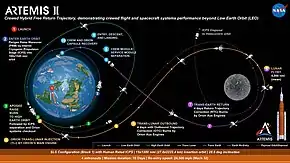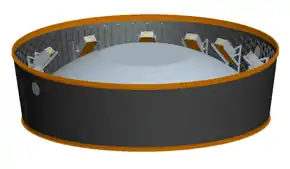Artemis 2
Artemis 2 (officially Artemis II[4]) is the first scheduled crewed mission of NASA's Orion spacecraft, currently planned to be launched by the Space Launch System in August 2023.[1][5] The current plan is for a crewed Orion spacecraft to perform a lunar flyby test and return to Earth. This is planned to be the first crewed spacecraft to travel beyond low Earth orbit since Apollo 17 in 1972. Formerly known as Exploration Mission-2 (EM-2), the mission was renamed after the introduction of the Artemis program. Originally, the crewed mission was intended to collect samples from a captured asteroid in lunar orbit by the now canceled robotic Asteroid Redirect Mission.[6]
 Summary of the Artemis 2 mission | |
| Names | Exploration Mission-2 (EM-2) |
|---|---|
| Mission type | Crewed lunar flyby |
| Operator | NASA |
| Mission duration | 10 days (planned) |
| Spacecraft properties | |
| Spacecraft | Orion CSM-003 |
| Manufacturer |
|
| Start of mission | |
| Launch date | August 2023[1] |
| Rocket | SLS Block 1 |
| Launch site | Kennedy, LC-39B [2] |
| Contractor | NASA |
| End of mission | |
| Landing site | Pacific Ocean[3] |
| Flyby of Moon | |
| Distance | Planned: 4,000 NM (7,400 km) |
Mission objectives
Previous
Until 2017, Exploration Mission-2 was a projected single-launch mission of a Space Launch System (SLS) Block 1B with an Exploration Upper Stage, lunar Block 1 Orion spacecraft, and a payload insertion of 50.7 t (112,000 lb). The plan was to rendezvous with an asteroid previously placed in lunar orbit by the robotic Asteroid Redirect Mission and have astronauts perform space-walks and gather samples.[7] After the cancellation in April 2017 [8] of the Asteroid Redirect Mission, an eight-day mission was proposed with a crew of four astronauts, sent on a free return trajectory around the Moon.[9] Another proposal suggested in 2017 was to take four astronauts aboard Orion on an 8-to-21-day trip around the Moon to deliver the first element of the Deep Space Gateway.[10]
Current
_(cropped).jpg.webp)
In March 2018, it was decided to launch the first lunar Gateway module on a commercial launch vehicle [11] because of delays in building the Mobile Launcher needed to hold the more powerful Exploration Upper Stage.[12] As of 2018, the Artemis 2 mission plan is to send four astronauts in the first crewed Orion capsule into a lunar flyby for a maximum of 21 days. The mission profile is a multi-translunar injection (MTLI), or multiple departure burns, and includes a free return trajectory from the Moon. Basically, the spacecraft will orbit Earth twice while periodically firing its engines to build up enough velocity to push it toward the Moon before looping back to Earth.[13]
Crew
The four-person crew of Artemis 2 will include a Canadian Space Agency (CSA) astronaut, the first Canadian to travel beyond low Earth orbit, under the terms of a 2020 treaty between the United States and Canada.[14]
| Position | Astronaut | |
|---|---|---|
| TBA | TBD spaceflight | |
| TBA | TBD spaceflight | |
| TBA | TBD spaceflight | |
| TBA | TBD spaceflight | |
Secondary payloads

NASA's CubeSat Launch Initiative (CSLI) is seeking proposals from U.S. institutions and U.S. companies to fly their CubeSat missions as secondary payloads aboard the SLS on the Artemis 2 mission.[15][16] NASA will accept proposals for both six-unit (12 kg) and 12-unit (20 kg) CubeSats.[17] As with the Artemis 1 mission, the CubeSats flying on Artemis 2 will be mounted on the inside of the stage adapter ring between the SLS upper stage and the Orion spacecraft, and will be deployed after Orion separates.[17] Selections were planned to be made by mid-February 2020,[15] but this date passed without any official announcement.
Launch date
During preliminary reviews in 2011, the launch date was placed somewhere between 2019 and 2021, but afterwards the launch date was delayed to 2023 on an SLS rocket.[18][19] As of July 2020, Artemis 2 is projected to launch no earlier than August 2023.[1]
Similar missions
In 1968, the Apollo 8 mission, crewed by three astronauts, was designed to test-fly command and service module beyond low Earth orbit. Although similar to Artemis 2 in that it was crewed and did not land on the Moon, it differed by entering lunar orbit for an extended stay.[20] Apollo 13 (1970) was the only Apollo mission that flew past the Moon by a free-return trajectory.
In 2005, the company Space Adventures announced plans to take two tourists within 100 km (62 mi) of the lunar surface using a Soyuz spacecraft piloted by a professional cosmonaut. The mission, named DSE-Alpha, has been priced at US$150 million per seat and is expected to last 8–9 days when scheduled. Company CEO Eric Anderson stated in 2011 that one seat had been sold, but the launch date has continually slipped since the second seat remains unsold as of 2017.[21]
A SpaceX lunar tourism mission was initially proposed for late 2018 and would have been similar to Artemis 2 in crew size, with two space tourists paying for a free-return loop around the Moon and back to Earth, using the Crew Dragon capsule and launched on the Falcon Heavy.[22][23] After the first flight of Falcon Heavy in 2018, SpaceX announced that Falcon Heavy would not be used for crewed flights to focus their future development on Starship and indicated that the lunar mission would more likely be carried out with the Starship.[24][25] On September 14, 2018, SpaceX officially announced that it had signed one of the paying passengers, Yusaku Maezawa, for the #dearMoon project mission using the Starship, scheduled for 2023, and that he would invite 6 to 8 artists to join him.[26][27]
References
- "Report No. IG-20-018: NASA's Management of the Orion Multi-Purpose Crew Vehicle Program" (PDF). Office of Inspector General (United States). NASA. July 16, 2020. Retrieved December 28, 2020.
 This article incorporates text from this source, which is in the public domain.
This article incorporates text from this source, which is in the public domain. - Hill, Bill (March 2012). "Exploration Systems Development Status" (PDF). NASA Advisory Council. Retrieved July 21, 2012.
 This article incorporates text from this source, which is in the public domain.
This article incorporates text from this source, which is in the public domain. - Bergin, Chris (June 14, 2012). "NASA teams evaluating ISS-built Exploration Platform roadmap". NASASpaceFlight.com. Retrieved July 21, 2012.
- Artemis: brand book (Report). Washington, D.C.: National Aeronautics and Space Administration. 2019. NP-2019-07-2735-HQ.
MISSION NAMING CONVENTION. While Apollo mission patches used numbers and roman numerals throughout the program, Artemis mission names will use a roman numeral convention.
 This article incorporates text from this source, which is in the public domain.
This article incorporates text from this source, which is in the public domain. - Clark, Stephen (May 18, 2020). "NASA will likely add a rendezvous test to the first piloted Orion space mission". Spaceflight Now. Retrieved July 17, 2020.
- Foust, Jeff (March 25, 2015). "NASA Selects Boulder Option for Asteroid Redirect Mission". SpaceNews. Retrieved March 27, 2015.
- Wall, Mike (April 10, 2013). "Inside NASA's Plan to Catch an Asteroid (Bruce Willis Not Required)". Space.com. TechMediaNetwork. Retrieved April 10, 2013.
- Jeff Foust (June 14, 2017). "NASA closing out Asteroid Redirect Mission". SpaceNews. Retrieved September 9, 2017.
- Gary Daines, ed. (August 4, 2017) [Originally published: December 1, 2016]. "NASA's First Flight With Crew Will Mark Important Step on Journey to Mars". NASA. Retrieved December 8, 2017.
 This article incorporates text from this source, which is in the public domain.
This article incorporates text from this source, which is in the public domain. - Gebhardt, Chris (April 6, 2017). "NASA finally sets goals, missions for SLS – eyes multi-step plan to Mars". NASASpaceflight.com.
- "NASA FY 2019 Budget Overview". Quote: "Supports launch of the Power and Propulsion Element on a commercial launch vehicle as the first component of the LOP - Gateway (page 14)
 This article incorporates text from this source, which is in the public domain.
This article incorporates text from this source, which is in the public domain. - NASA may fly crew into deep space sooner, but there's a price, Eric Berger, Ars Technica, 12 April 2018, Quote: "Without the Exploration Upper Stage, NASA will not be able to fly, in a single flight, crew members and pieces of a deep space gateway it hopes to build near the Moon in the 2020s".
- NASA's First Flight With Crew Will Mark Important Step on Journey to Mars NASA - Last updated on February 9, 2018
 This article incorporates text from this source, which is in the public domain.
This article incorporates text from this source, which is in the public domain. - Connolly, Amanda (December 16, 2020). "A Canadian astronaut will be on NASA's Artemis deep space lunar orbit". Global News. Retrieved December 16, 2020.
- Hill, Denise (August 6, 2019). "NASA's CubeSat Launch Initiative Opens Call for Payloads on Artemis 2 Mission". NASA. Archived from the original on August 6, 2019. Retrieved August 6, 2019.
NASA is seeking proposals from U.S. small satellite developers to fly their CubeSat missions as secondary payloads aboard the SLS on the Artemis 2 mission under the agency's CubeSat Launch Initiative (CSLI)
 This article incorporates text from this source, which is in the public domain.
This article incorporates text from this source, which is in the public domain. - Klotz, Irene (August 5, 2019). "NASA Scouting Cubesats For Artemis-2 Mission". Aviation Week & Space Technology. Archived from the original on August 6, 2019. Retrieved August 6, 2019.
NASA on August 5 released a solicitation for cubesats to ride along with the first crewed flight of the Space Launch System rocket and Orion capsule, with the caveat that selected projects fill strategic knowledge gaps for future lunar and Mars exploration
- NASA seeking proposals for cubesats on second SLS launch. Jeff Foust, Space News. 8 August 2019.
- "NASA's Deep Space Exploration System is Coming Together". NASA. March 8, 2019.
 This article incorporates text from this source, which is in the public domain.
This article incorporates text from this source, which is in the public domain. - Sloss, Philip (December 28, 2018). "Crewed Orion spacecraft passes critical design review". NASASpaceflight.com. Retrieved March 9, 2019.
- Charlie Wood (February 25, 2017). "Apollo 8 redux: Why NASA may send humans around the Moon, again". The Christian Science Monitor.
- Moseman, Andrew (April 26, 2011). "Just One US$150 Million Seat Remains on Space Adventures' Lunar Flyby". Popular Mechanics. Retrieved June 4, 2017.
- "SpaceX promises a Moon vacation in 2018". The Verge. March 3, 2017 – via YouTube.
- Dave Trumbore (February 27, 2017). "SpaceX Will Attempt to Send Humans Around the Moon Next Year". nerdist.com. Archived from the original on March 5, 2017. Retrieved March 4, 2017.
- SpaceX no longer planning crewed missions on Falcon Heavy, Jeff Foust, SpaceNews, February 5, 2018
- Pasztor, Andy. "Elon Musk Says SpaceX's New Falcon Heavy Rocket Unlikely to Carry Astronauts". The Wall Street Journal. Retrieved February 6, 2018.
- Eric Ralph (September 14, 2018). "SpaceX has signed a private passenger for the first BFR launch around the Moon". Retrieved September 14, 2018.
- Grush, Loren (September 14, 2018). "SpaceX says it will send someone around the Moon on its future monster rocket". The Verge. Retrieved September 15, 2018.
.svg.png.webp)
